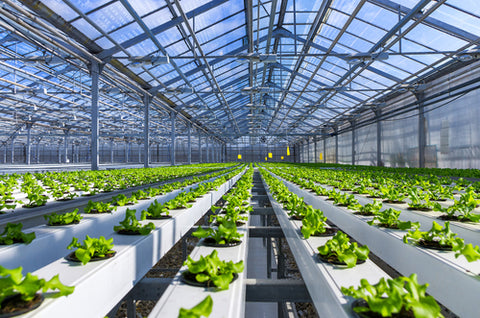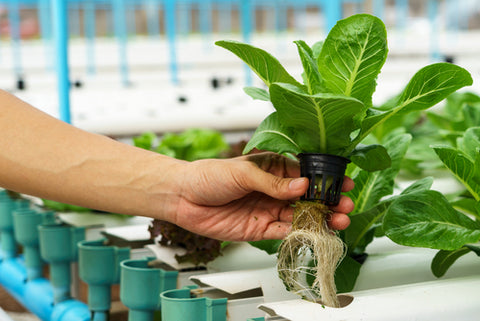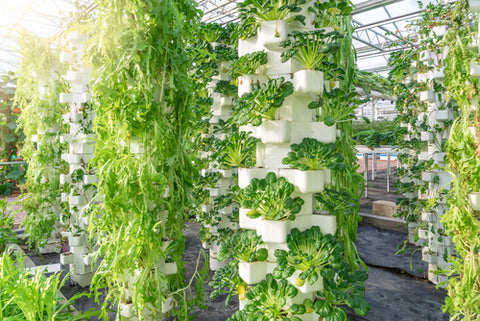
What Is Hydroponic Gardening?
Hydroponic gardening is a growing trend in the agriculture world, and it’s only increasing in popularity as equipment, technologies, and social awareness streamline the gardening process. For home growers and commercial farmers alike, hydroponic gardening is proving to be the future of year-round produce.
Hydroponic gardening has been around for thousands of years, dating back to the 7th century BC. In fact, the Gardens of Babylon and the Floating Gardens of China are both early examples of hydroponic gardening. Their hydroponic aspect is what has allowed these gardens to thrive despite external factors.
However, it wasn’t until 1950 that farmers and scientists began experimenting with hydroponic gardening as a large-scale agricultural process. Now, hydroponic gardening is taking the agricultural world by storm.
What Is Hydroponic Gardening?
The word hydroponics comes from the Greek “hydro” for “water” and “ponics” for “labor.” Hydroponic gardening is a soilless gardening process that uses mineral nutrient solutions to feed plants housed in an aquatic-based environment.
All plants need three things in order to thrive: water, nutrients, and sunlight. In traditional growing, plants receive water and nutrients through the soil. Take away the soil, and the plants die.
But hydroponic gardening delivers these nutrients to the water without soil.

The plant roots come into direct contact with the nutrients and oxygen through a suspension in a nutrient solution. This solution is delivered directly into the plant's roots without the need for soil. To support the plants, some systems use a “growing medium,” such as clay pebbles, coconut coir, or perlite. The hydroponic system also aerates and supports the roots of the pants so that the plant can have greater access to oxygen and direct nutrients.
Hydroponic gardening is often used where traditional farming isn’t an option. It’s especially popular in large cities, where citizens want fresh food but don’t have access to agriculturally viable land. A number of urban developers have purchased empty warehouses and shipping containers to build city-based hydroponic gardens.
These gardens provide fresh produce and local food supplies in a way that can drastically benefit urban communities; offering low-cost, high-quality produce will see positive results in healthcare, education, and productivity rates.
Hydroponic gardens are also increasingly popular for home growers who want an easy, sustainable way to have fresh produce. Soilless gardening is less messy, has a more controllable growing environment, and provides a higher yield. Moreover, these indoor plants can actually improve the quality of air, which can enhance health and mood in residential homes.
What Are The Types Of Hydroponic Gardening?
Hydroponic systems are either active or passive. Active systems require pumps and mechanical devices that deliver the nutrient solution to the plant’s roots at the most opportune time. These have recovery systems that recycle nutrient solutions and water, reducing cost and resource expenditure. These rely heavily on electricity and technology to work. Passive systems are easier to set up and maintain as the nutrient solutions are delivered through a growing medium.
There are six main types of hydroponic gardening.
1. Drip Systems
Drip systems are the most widely used hydroponic system. Plants are suspended in a growing medium with water and are slowly fed a nutrient system. These systems use a timer to turn on a pump, which delivers nutrients into the root zone on a cyclical schedule. These systems can easily recycle any excess or unused nutrient solution that isn’t absorbed by the plant.
2. Wick System
Similar to the drip system, plants are suspended in a growing media over a nutrient solution. One end of a wick, usually made of rope or fiber, is attached to the growing media and the other end is hanging in the nutrient solution. The wick then soaks up the nutrient solution to deliver directly to the plant roots in the growing media. While the drip system uses a pump and timer, the wick system is less technological and will deliver nutrients on a consistent basis to the plants.

3. Deep Water Culture Systems (DWC)
In DWC systems, the plants are held up by some sort of supportive platform. The plants hang directly above the nutrient solution and are constantly exposed to the water-based solution of nutrients. Oxygen is provided through a separate air pump. This is the most common system for lettuce and leafy greens.
4. Aeroponic Systems
These operations are the most high-tech and costly. Roots are suspended in air over mist nozzles. The nozzles then mist the roots with a nutrient solution on a cycle. This calls for a lot of technology equipment and know-how, so it’s usually best for advanced hydroponic gardeners.
5. Nutrient Film Technique Systems
These systems are popular for commercial hydroponic farms. The plants are grown in long channels with the nutrient solution running along the bottom of the channel. At the end of the row, the leftover solution is recycled into a main reservoir to be reused. This system requires pumps and timers to properly regulate the delivery of the nutrient solution and water.
6. Ebb And Flow Systems
Ebb and flow (or flood and drain) systems are not as popular but they’re still effective. Plants are grown in a tray with a growing medium and are cyclically flooded with a nutrient solution. After the flooding period, the leftover solution drains back into the reservoir until the next flooding.
Vertical Gardening
Often, hydroponic gardening is combined with vertical gardening. Vertical farms are stacked layers of plants housed vertically, as opposed to grown in the traditional horizontal space. This use of air space allows for a greater number of plants in a single area. This also pulls gardening away from outdoor weather conditions to maintain climate control indoors.
Together, hydroponic and vertical gardening provide more possibilities for indoor and urban gardening, providing fresh produce to areas with severe climates or without extensive agricultural land. This mixture of hydroponic and vertical systems has allowed for hydroponic farming on a mass scale.

What Are The Benefits Of Hydroponic Gardening?
Hydroponic gardening is proving successful in a number of agricultural processes, both residentially and commercially. Overall, hydroponic plants are healthier, happier, and more fruitful.
- Hydroponic gardening is not limited by climate or season. Growers can cultivate fresh produce year-round indoors without the concerns of dry or wet soil.
- It is not subject to the same bugs or infestations, which are usually bred and nourished in soil.
- Because it is not susceptible to soil-borne diseases or pests, hydroponic gardening requires fewer pesticides, allowing for healthier plants and consumers.
- Hydroponic vertical gardening occupies less space and can be held indoors.
- The nutrients are delivered right to the plant, so the plant conserves energy that it would usually use to find and break down its food. This energy conservation allows hydroponic plants to have a faster growth rate.
- The conservation of energy along with the year-round season allows for significantly higher yields than traditional farming. The growing process is constantly restarting, so farmers estimate that yields are nearly double that of typical gardening.
- Many farmers believe the quality of produce is higher when grown hydroponically, as the plants can accept higher levels of nutrients and oxygen.
- Hydroponic systems stimulate root growth and deliver higher amounts of oxygen. This oxygen allows plants to absorb nutrients faster and have a stronger process of photosynthesis.
- Hydroponic gardening uses less water than soil gardening, making it more environmentally conscious. It uses about one-twentieth the amount of water as traditional gardening.
- Hydroponic water recycles and reuses nutrients and water. Unlike with soil, hydroponic systems have no run-off, which typically degrades the surrounding environment.
- There is no topsoil or soil in hydroponic gardening, so topsoil erosion and soil rotation are not concerns for farmers.
- Hydroponic gardening requires minimal labor and upkeep compared to traditional agriculture. It’s much easier to harvest and replant without having to dig through soil.
What Are The Disadvantages Of Hydroponic Gardening?
Though there are more benefits than disadvantages to hydroponic gardening, there are still some restrictions for a number of growers.
Most importantly, the initial set-up costs for an entire hydroponic farm can be expensive. Large-scale farming can cost millions of dollars to implement the necessary equipment, technology, and training needed. Most of today’s farmers don’t have access to those kinds of funds to make the switch—even though the long-term return on investment is high.
Secondly, active hydroponic systems rely heavily on electricity. If the power goes out, the plants can quickly dry up. One power outage could cause an entire loss of crops. Moreover, large-scale hydroponic farms have high levels of power consumption because they often rely on artificial lighting to maintain their indoor plants. This energy expenditure can be massive, environmentally unconscious, and expensive.
These disadvantages have prevented hydroponic gardening from being implemented on a large scale to date. However, scientists have been working to overcome these disadvantages quickly. Hydroponic systems are soon becoming an economically viable alternative, the likes of which will change the future of gardening forever.
The Bottom Line
Hydroponic gardening is quickly gaining a foothold in both residential and commercial spaces. You can have a year-round farmer’s market right in your shed or the empty office in your business. Thanks to tech advancements and a growing social awareness, hydroponic gardening is more affordable and accessible than ever.
Are you interested in starting a low-cost, high yield hydroponic garden in your home or business? Check out our hydroponics products here to get started!

Leave a comment